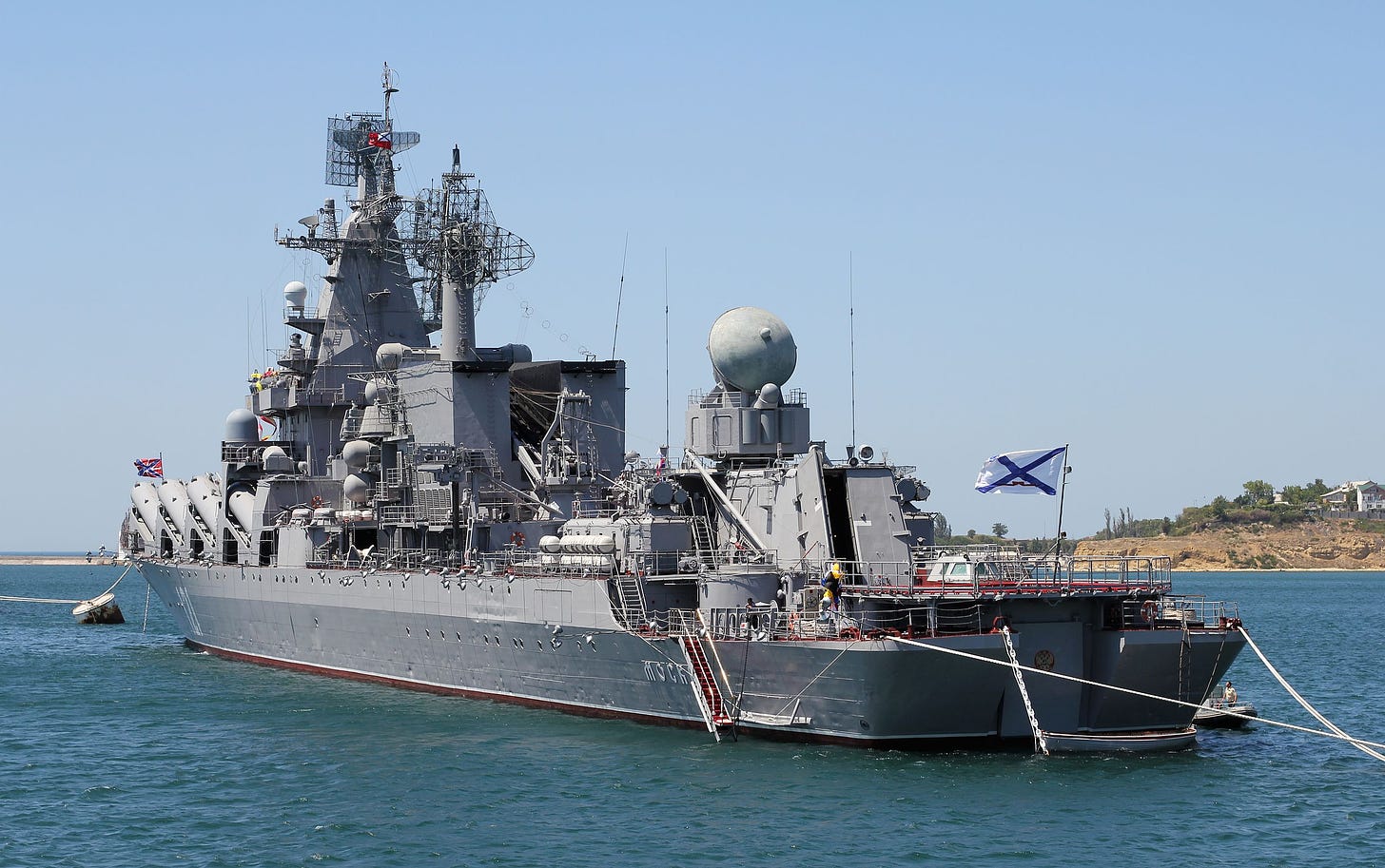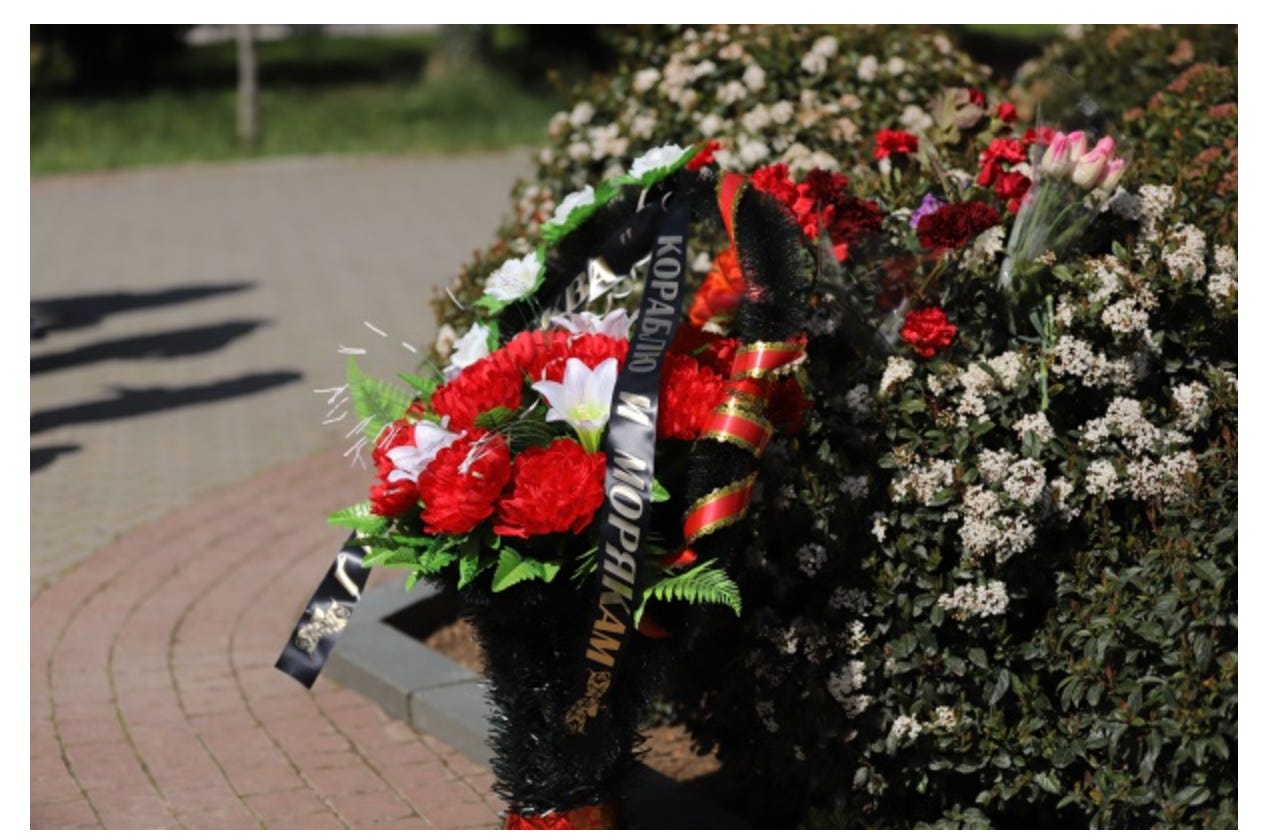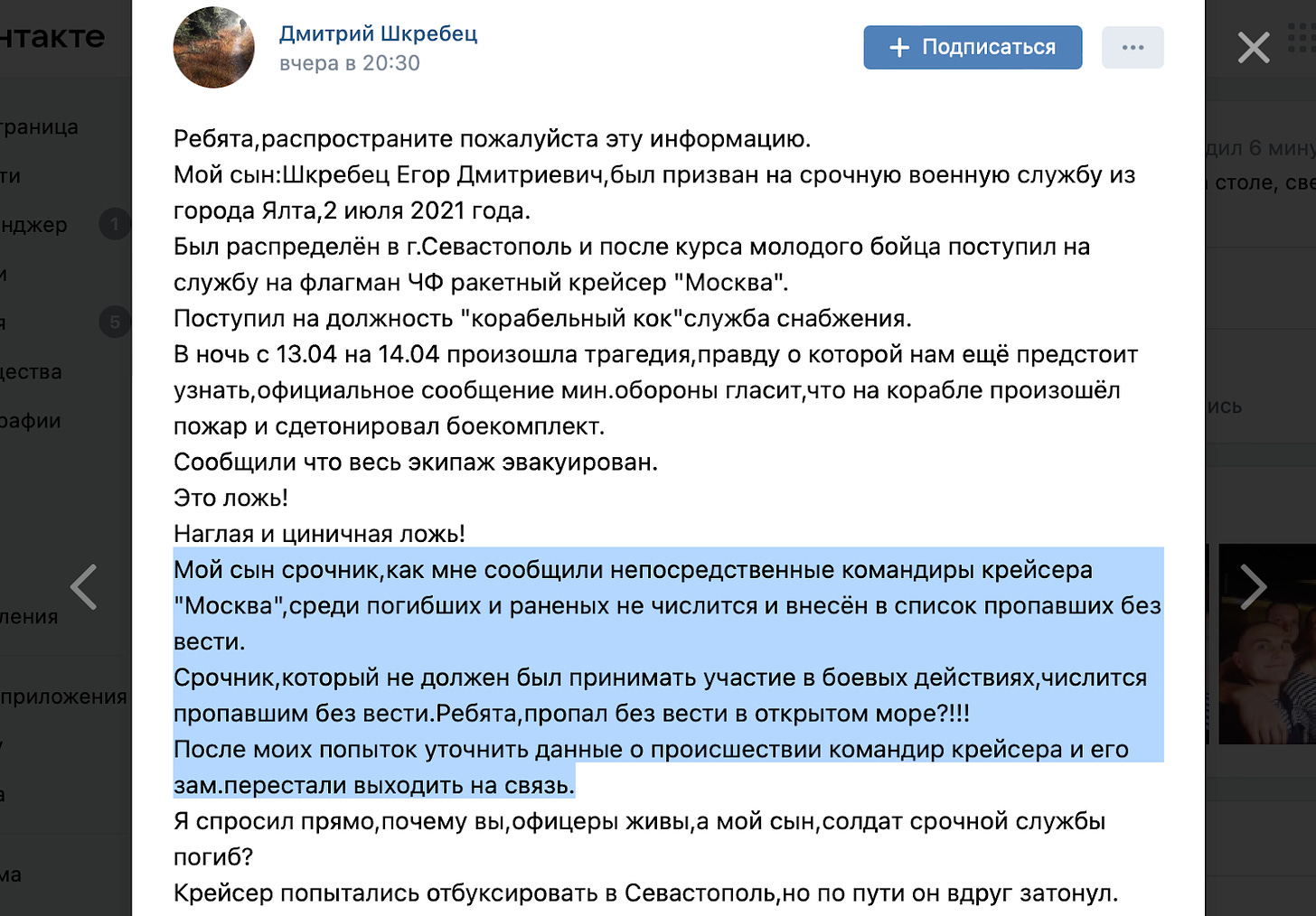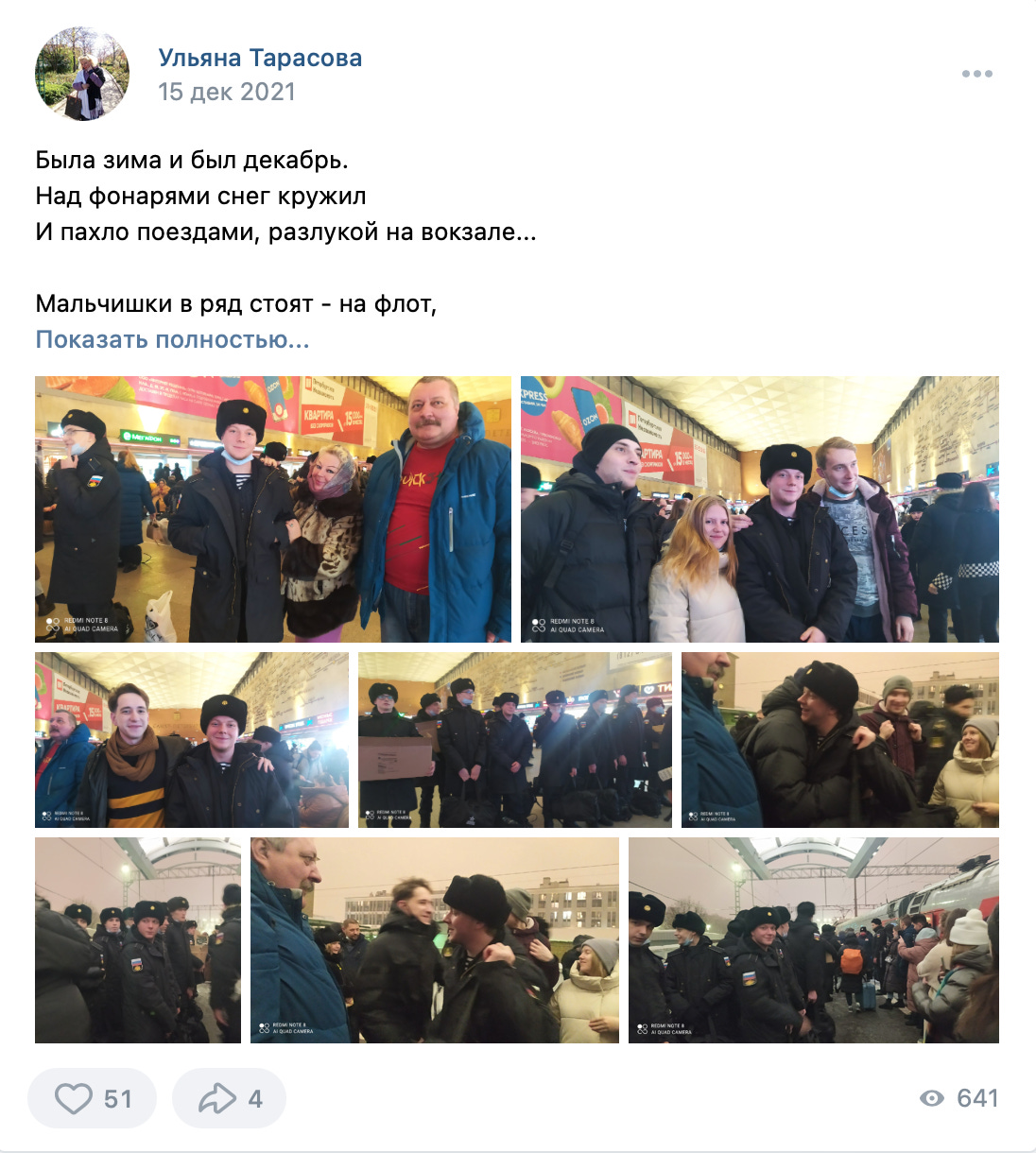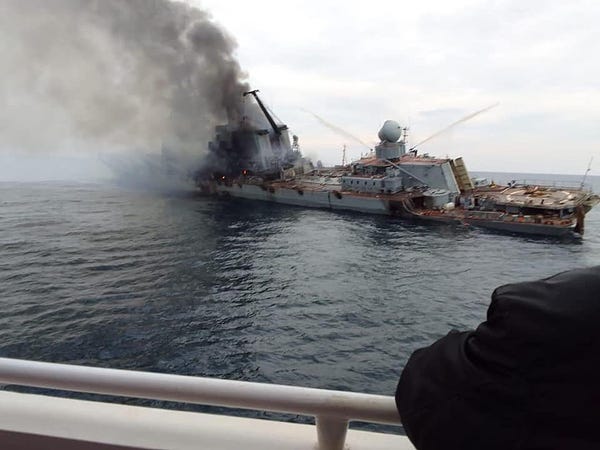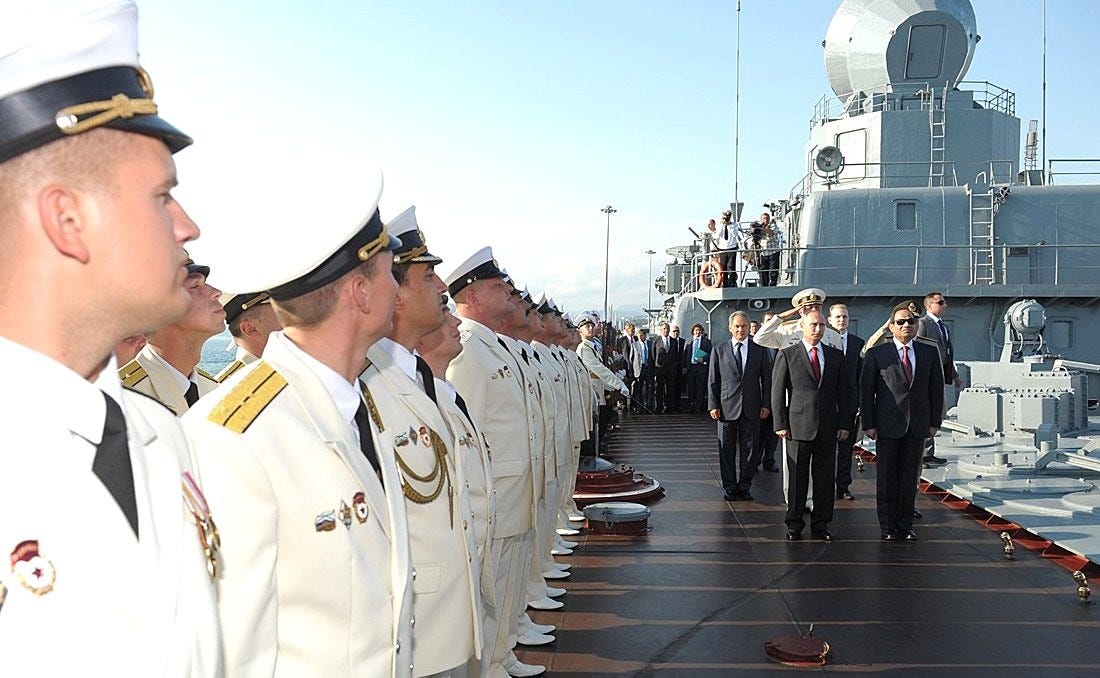Ukraine Crisis: truth that sunk with Russian flagship “Moskva”
Five days after Russia’s flagship missile cruiser “Moskva” sank in the Black Sea near Sevastopol, the plight of the crew — and the actual reason of the incident, have been the biggest question marks.
The defense officials have not specified the exact number of people who were onboard at the time of the fire that caused detonation of the ship’s ammunition — as well as the reasons for the fire.
Losing a flagship cruiser is a serious blow to Russia’s image in the ongoing standoff with Ukraine, primarily because of the public damage. While the real significance of the cruiser for Russia’s military capability is being debated in the professional community, the loss of the crew (510 people as per the vessel’s specification) would be irremediable.
Photo: George Chernilevsky
Russia has not revealed any numbers of the size of the crew onboard at a time of the incident, or the possible casualties — which is logical during wartime. “The crew was evacuated”, the Russian Defense Ministry said in the very first announcement of the incident on the vessel. Later another state news agency reported the crew was taken to the city, without specifying any numbers.
To be sure, reporting any numbers related to troops’ movement or losses can lead to criminal prosecution under Russia’s new law against “fake news”, with up to 15 years in prison.
Two days after the cruiser sank, the Defense Ministry has for the first time released a video with its crew members. In a 20-second video Commander-in-Chief of the Navy Admiral Nikolai Yevmenov is shown in front of sailors on a parade ground in Sevastopol. It is not clear when the meeting took place. Analyzing the video released by MOD, various commenters estimate some 100-240 were present.
A longer version of the video released by “Zvezda” TV channel shows the Navy chief saying that the officers, midshipmen and sailors of the “Moskva” crew who are on a contract service would continue to serve in the Russian Navy, while conscript soldiers (there is a 12-month compulsory enrollment for all male citizens aged 18–27, with a number of exceptions, in Russia) will be terminated and sent home in the period from May to July, as per the law.
The latter statement has not been included in most of the media reports, as involvement of the conscripts in Russia’s “special military operation” sparked outrage in the very beginning. In March, the Defense Ministry admitted conscript soldiers were participating in the operation, but “most were already withdrawn [from the Ukrainian territory]” and measures would be taken to “prevent dispatch of conscripts to combat areas”.
The people
On Friday, a cruiser farewell ceremony was held in Sevastopol, with a funeral wreath saying "to the ship and sailors" captured by the journalists’ cameras.
Photo: VK Account “Неповторимый Севастополь”
Ukrainian and international media have reported the cruiser’s first rank captain Anton Kuprin has died, citing a Telegram post of Anton Gerashenko, an advisor of the Ukrainian Ministry of Internal Affairs (he was dismissed from the post of deputy minister of the same ministry in 2021) and another Telegram post of the State border service of Ukraine. However, Kuprin can be identified in the beginning of the video released by MOD.
Pro-Russian telegram channel “Voina s feikami” (War against fakes) noted that various Ukrainian officials have earlier posted “fake” information on destroying higher ranked commanders and even brigades (who later posted videos of them being well alive to refute the claims). “The death of the captain of the "Moskva", if it really happened, would be one of the main topics, both in Russia and globally,” the author of the post said.
However, several media outlets (all of them are designated as “foreign agents” in Russia and are not operating in the country) claim to have spoken to relatives of the crew members. Their statements, if confirmed, suggest there could be many injured and some missing. Journalists of the US state-funded RFE/RL suggest they have identified at least one person who allegedly served on the cruiser and died in the incident — midshipman Ivan Vakhrushev, providing screenshots of his wife’s account in Odnoklassniki social network.
The same media has also found a post in Russian social network VK by Dmitry Shkrebets who says his son Egor, a conscript soldier, was on the cruiser and is now missing.
“My son is a conscript, as I was informed by the direct commanders of the cruiser “Moscka” he is not listed among the dead and wounded and is listed as missing. The conscript, who was not supposed to take part in the fighting, is listed as missing. Guys, missing in the high seas?!!! After my attempts to clarify the data about the incident, the commander of the cruiser and his deputy stopped contacting us”, Shkrebets wrote on April, 17 (his first post was deleted).
In another post, Shkrebets noted that his family was contacted by three families from Yalta, Alupka and Petersburg, whose children are also missing, all of them are conscripts. “Today we wrote statements together at the local military enlistment office, tomorrow they will be at the military commissariat of Simferopol. We need written answers to our questions about our children, and not text messages with pictures and wishes to pray… Here on the spot, everyone was responsive to our pain, [we are] very grateful”, he wrote.
The mother of Egor Shkrebets told the Latvia-based media outlet The Insider (no relation with NYC-based Insider, Inc.), also recognized as “foreign agent” in Russia, she and her husband have visited a hospital and saw some 200 wounded “Moskva” crew members, but could not find their son. Dmitry Shkrebets in his posts in VK does not mention any visit to the hospital.
Media outlet “Agentstvo” (the Agency), formerly known as ‘Proekt” and labeled as “undesirable” in Russia, found a mother of another conscript soldier Mark who is also reportedly missing. “Agentstvo” identified her as 47-eyar old Uliana Tarasova. On April 16, Uliana shared a post in her VK account that talks about army men fighting for Russia and dying in Ukraine, authored by Christian TV Channel “Spas” head Boris Korchevnikov. In another post dated December 15, Uliana is pictured with her son and other young men in uniform at a crowded Moskovsky Railways station in St Petersburg train station. The boys are leaving for their place of service… In Uliana’s own poem, accompanying the pictures, she wrote:
“The boys are standing in a row - for the Navy service,
The train will take them soon away,
And they fell so amazed to
What has brought them here.
Families are seeing’em off —
Clad in uniform, looking high
So they shine with youth!
And here my boy, like others,
His eyes sparkling with excitement,
Something important awaits him —
Growing up, throwing everything away,
Not to forget the past, but “new” is so desired —
How difficult it is to let him float away
To the world of adults, and prophecy!
His friends are here,
And they know
He’s far away from them,
He floats with his own current...”
Novaya Gazeta Europe (a new media outlet operating outside Russia after Novaya Gazeta has suspended its operations in the country) published a conversation with a mother of a conscript soldier who called her on April, 15, a day after the cruiser sank.
“He calls me and cries because of what he saw. It was scary. It is clear that not everyone survived. They tried to put out the fire on their own, after three Neptune missiles hit the cruiser. As a mother, I don't even know what words to choose. I'm just very happy that my son called me, that he's alive and well,” the woman told the media outlet. She added that she cannot publicly speak about it (hence her name is not revealed) because it may hurt her son. “They signed a non-disclosure agreement before they got on the cruiser,” the mother added.
The flagship
Moskva, a Project 1164 ship, was the flagship of the Black Sea fleet. It was commissioned in 1983 under the name of “Slava” (Glory). The flagship carried 8 S-300F launchers, 16 Vulkan anti-ship missiles as well as anti-submarine and mine-torpedo weapons. The cruiser was deployed in various hot spots including Georgia and Syria (2015).
Ukraine has claimed the cruiser was “seriously damaged” after it was attacked by two Neptune missiles in the late evening of April, 13. The announcement was made by the head of the Odessa Regional Military Administration Maxim Marchenko made an announcement in his Telegram channel.
Russia has reported some 5 hours later (in the early morning of April, 14) the cruiser was seriously damaged as “its ammunition detonated as a result of the fire”. Later in the day, the Russian Defense Ministry said the cruiser “retained buoyancy” with the key missile armament intact and the source of the fire “localized”. It added the crew was evacuated to the nearby ships. Some 9 hours later, TASS reported the flagship sank while being towed in a storm.
Over the weekend, some images and footage of allegedly “Moskva” cruiser started doing rounds in the social media. Twitter user OSINTtechnical, who doesn defense analysis based on the open data, could not verify the authenticity of the images, although he noted that the photo was indeed a Slava-class cruiser.
The reason for the fire on the ship is still being debated. According to Ukraine and the Pentagon, the ship was hit by Ukraine-made Neptune missiles. Russia has not confirmed the attack. It is impossible to independently verify any of these versions.
Some experts in Russia claim Neptune missiles are not yet ready to be operated (in December, Ukrainian media said the first division of the RK-360MC anti-ship coastal missile system will be ready by the beginning of 2022). Russian experts suggest that instead a US-designed subsonic anti ship cruise missile The Harpoon (RGM-84/UGM-84/AGM-84) or any of its European variants could have been used.
However, since such weapon could only be operated by NATO specialists, and considering how diligently Washington stays away from directly getting into the conflict, such a version is unlikely. Another possibility is an unguided aircraft rocket or a tactical missile delivered by a fighter jet. What remains to be answered is why the only ship in the Black Sea having long-range air defense capabilities could not use them when it was attacked. Some versions suggest the system was “blinded” by Turkish-made Bayraktar TB-2 drone which made it vulnerable to the missiles.
Photo: Vladimir Putin and Egyptian President Abdel Fattah Sisi visited the Moskva Guards missile cruiser, Sochi, 2014. Sourse: www.kremlin.ru
“This [version of events] is more likely than not: the [Ukrainian] Su-24s still appear here and there, they do have ammunition, Ukrainian pilots demonstrated sufficient qualifications during the conflict, and West-assisted geolocation of targets makes their job easier, especially taking into account reports about the poor state of the ship's air defense,” the author of “Oboronka” Telegram channel noted.
When analyzing the photo of the cruiser mentioned above, the same commenter noted that the ship was leaning to the left side, which could serve as proof of a missile attack. There may have been another hit, but there is no smoke, and apparently that fire was extinguished.
This, according to the commenter, refutes the version of a spontaneous detonation of the ammunition (in that case the fire and smoke would be seen either to the right, where S-300 launchers are located, or to the left – where Vulkan missile launchers are placed).
Still, the “detonation” version cannot be thrown out completely, given the range of ammunition onboard as well as the fact the fire extinguishing system of this cruiser was believed to be outdated. In fact, the ship underwent repairs in 2017-2019, but it was not seriously modernized, Ilya Kramnik, Research Fellow, Center for North American Studies, IMEMO, told “RBK” news outlet. He added that the ship didn’t receive some of the modern combat systems as well as modern fire extinguishing systems which could be “one of the factors that affected the crew's ability to fight the fire”.
The loss of “Moskva” is a huge reputational hit, defense expert H I Sutton points out. While the flagship was the only vessel in the Black Sea Fleet equipped with long-range air defense capabilities that could protect other ships, many commenters admit, it will not have a significant impact on the state of affairs in the ongoing standoff. "It's more about psychological damage than material damage," Mykola Bielieskov from Ukraine's National Institute for Strategic Studies told the BBC. “[The loss of the cruiser] is unlikely to have an impact on the battle in Ukraine, since the main activities are carried out on land. The cruiser’s role was primarily to provide information from its radar system to the rest of the ships,” Kramnik believes.
P.S.
Ukrainian and western media reports suggest it was “Moskva” cruiser to whom a famous phrase “Russian warship, Go f** yourself” was addressed by the guards of Snake island, despite the cruiser being accompanied by a patrol ship “Vasily Bykov” when the island was captured by Russia. “Vasily Bykov” was supposedly “destroyed” by Ukraine in early March, only to be later found intact in Sevastopol (do not miss this analysis by The Drive).
To be sure, the Ukrainian and western media wouldn't like to recall that the infamous defenders of the Snake island, who were posthumously awarded honors as war heroes, were soon found “alive and well” after they surrendered to Russians. Some of them already returned to Ukraine in a POWs exchange in March. Winning the “information war” has never been more important for both Russia and Ukraine, not just for the sake of global sympathy, but as a morale booster. But the outcome of this conflict will be rather decided on the battlefield.



